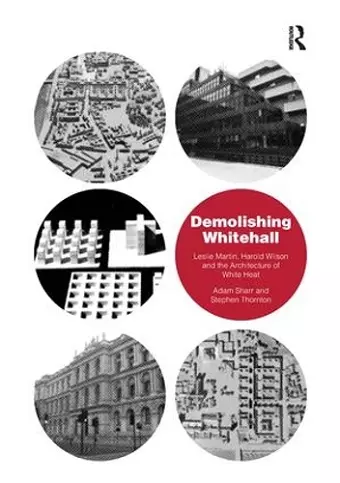Demolishing Whitehall
Leslie Martin, Harold Wilson and the Architecture of White Heat
Stephen Thornton author Adam Sharr author
Format:Paperback
Publisher:Taylor & Francis Ltd
Published:16th Nov '16
Currently unavailable, and unfortunately no date known when it will be back
This paperback is available in another edition too:
- Hardback£150.00(9781409423874)

This book is about a lost world, albeit one less than 50 years old. It is the story of a grand plan to demolish most of Whitehall, London’s historic government district, and replace it with a ziggurat-section megastructure built in concrete. In 1965 the architect Leslie Martin submitted a proposal to Charles Pannell, Minister of Public Building and Works in Harold Wilson’s Labour government, for the wholesale reconstruction of London’s ’Government Centre’. Still reeling from war damage, its eighteenth- and nineteenth-century palaces stood as the patched-up headquarters of an imperial bureaucracy which had once dominated the globe. Martin’s plan - by no means modest in conception, scope or scale - proposed their replacement with a complex that would span the roads into Parliament Square, reframing the Houses of Parliament and Westminster Abbey. The project was not executed in the manner envisaged by Martin and his associates, although a surprising number of its proposals were implemented. But the un-built architecture is examined here for its insights into a distinctive moment in British history, when a purposeful technological future seemed not just possible but imminent, apparently sweeping away an anachronistic Edwardian establishment to be replaced with a new meritocracy forged in the ’white heat of technology’. The Whitehall plan had implications well beyond its specific site. It was imagined by its architects as a scientific investigation into ideal building forms for the future, an important development in their project to unify science and art. For the political actors, it represented a tussle between government departments, between those who believed that Britain needed to discard much of its Victorian and Edwardian decoration in the name of ’professionalization’ and those who sought to preserve its ornate finery. Demolishing Whitehall investigates these tensions between ideas of technology and history, science and art, socialism and el
’This is a highly original book. It explores a forgotten moment in Britain’s post war history, one in which the country briefly embraced modernity without qualification. The authors use the plan to transform Whitehall’s architecture to ask who were Britain’s true modernisers and, in answering the question, they make a striking contribution to our understanding of Britain’s political and cultural history.’ Steven Fielding, Centre for British Politics, University of Nottingham, UK ’Briefly, in the 1960s, things were very different. Forged in the white heat of technological innovation, a grand project proposed the demolition and rebuilding of most of Whitehall. The work of Leslie Martin, it aimed not only to re-shape the physical heart of government, but also to re-cast the foundations of architecture on a scientific theory of form. Sharr and Thornton’s re-telling of this largely forgotten story is fascinating in detail and gripping in its narrative sweep.’ Richard Weston, Cardiff University, UK 'What an amazing saga. Officially commissioned early in 1964 to produce what would now be described as a ’masterplan’ for the government quarter, the Whitehall area of London. ...The story deserves to be known and is well told by Adam Sharr and Stephen Thornton.' Architectural Review 'What might have been a dry, academic investigation into a government planning exercise is instead imbued with wit, charm and novel insight.' Architecture Today 'The authors skilfully locate the scheme within its intellectual, architectural and cultural contexts'. Twentieth Century Society journal 'Chapters begin with clear introductions and the conclusions/summaries are highly instructive ... It makes a very useful wider contribution to several disciplines: certainly it should prove highly relevant to those working in the discipline of post-war planning and architecture, but it also helps to develop our broader understanding of modern culture in mid-twentieth
ISBN: 9781138277175
Dimensions: unknown
Weight: 453g
328 pages